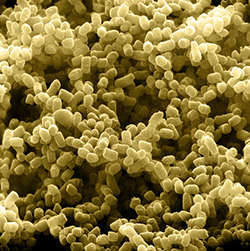
E. coli bacteria. The most common number cited for how much bacteria each person carries is almost certainly wrong. Credit David M. Phillips/Science Source
There are a lot of bacteria on us and in us – our microbiome, it is called. Calculating exactly how many microbes each of us carries is hard, and the most common number cited, both in popular and scientific literature, is almost certainly wrong.
In 1972, Thomas D. Luckey published an article in The American Journal of Clinical Nutrition in which he wrote that an adult male had 100 x 1012, or 100 trillion, microbes in his gut, and another one trillion on his skin. He gave no reference for either figure.
Another scientist, D. C. Savage, cited Dr. Luckey in a review published in 1977, writing that “the normal human organism can be said to be composed of over 1014 cells, of which only about 10 percent are animal cells.” So, he used Dr. Luckey’s number, 100 trillion, for bacteria, and added that one-10th of those – 10 trillion – were human cells.
This neat ratio caught on, and the phrase “10 times as many microbial cells as human cells” is often repeated, as it is on the website of the Human Microbiome Project of the National Institutes of Health, where presumably they know something about the microbiome.
A recent estimate put the number of human cells at 37.2 trillion, but Dr. Savage’s ratio has survived. Using the 10-to-1 formula, the number of bacteria would be about 372 trillion, and there it has stood.
But now a group of Israeli scientists has concluded that 372 trillion cannot be right. Their new analysis was published in the Jan. 28 issue of the journal Cell, with more details and calculations available online.
Using one cubic micrometer as the volume of a single bacterium, they made their estimates based on the volume of the organs that contain microbes, along with the likely concentrations of bacteria in each place. The researchers estimate that the large intestine, where most of our microbiome lives, contains 39 trillion bacterial cells. Other places – the skin, the mouth, the small intestine and stomach – contain very few bacteria, and together add only a small amount to the total.
Why is this knowledge useful? “Sometimes you can’t show why on the spot,” said one of the authors, Dr. Shai Fuchs. “But getting in the habit of using the best numbers available is important. If you can make a better estimate today than 10 years ago, it’s a worthwhile effort.”
Dr. Fuchs, along with his co-authors, Ron Milo and Ron Sender, wrote the analysis when he was a doctoral student at the Weizmann Institute of Science in Israel.
Of course, this is still only an estimate, based on a 155-pound man 20 to 30 years old and 5 feet 7 inches tall. The size of the microbiome varies by age, sex, height and weight, and even changes moment to moment: One bowel movement liberates about a third of the bacteria in the colon.
But, the researchers conclude, a realistic estimate of the number of microbes living in the human body is about 40 trillion – close to the number of our human cells.
